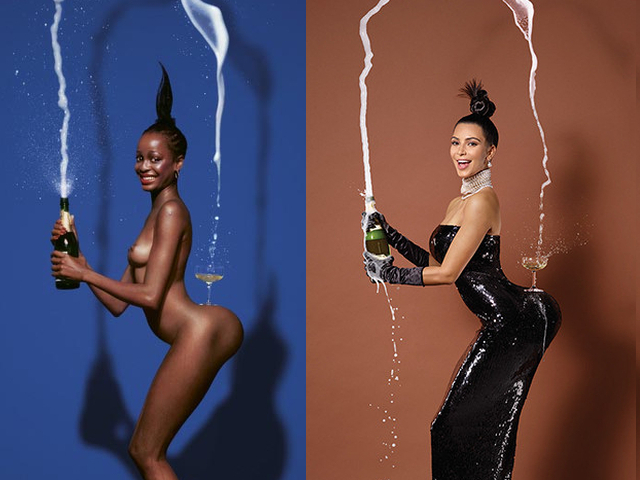That Piece About The Significance Of Sarah Baartman
Originally published on bbc.com
Two centuries ago Sarah Baartman died after years spent in European “freak shows”. Now rumours over a possible Hollywood film about Baartman’s life have sparked controversy.
Sarah Baartman died on 29 December 1815, but her exhibition continued. Her brain, skeleton and sexual organs remained on display in a Paris museum until 1974. Her remains weren’t repatriated and buried until 2002.
Brought to Europe seemingly on false pretences by a British doctor, stage-named the “Hottentot Venus”, she was paraded around “freak shows” in London and Paris, with crowds invited to look at her large buttocks.
Today she is seen by many as the epitome of colonial exploitation and racism, of the ridicule and commodification of black people.
Reports of Beyoncé planning to write and star in a film about Baartman have been denied by the singer’s representatives. But the rumours were enough to generate concern.
Jean Burgess, a chief from the Khoikhoi group that Baartman was from, argued that Beyoncé lacked “the basic human dignity to be worthy of writing Sarah’s story, let alone playing the part”. But Jack Devnarain, chairman of the South African Guild of Actors, said filmmakers had the “right to tell the stories of people you find fascinating and that’s what we must be careful not to object to”.
Even in denying any link to a film, Beyoncé’s representative said: “This is an important story that should be told.”
Baartman’s life was one of huge hardship. It is thought she was born in South Africa’s Eastern Cape in 1789, her mother died when she was two and her father, a cattle driver, died when she was an adolescent. She entered domestic service in Cape Town after a Dutch colonist murdered her partner, with whom she had had a baby who died.
In October 1810, although illiterate, Baartman allegedly signed a contract with English ship surgeon William Dunlop and mixed-race entrepreneur Hendrik Cesars, in whose household she worked, saying she would travel to England to take part in shows.
The reason was that Baartman, also known as Sara or Saartjie, had steatopygia, a genetic condition resulting in extremely protuberant buttocks due to a build-up of fat.
These made her a cause of fascination when she was exhibited at a venue in London’s Piccadilly Circus after her arrival. “You have to remember that, at the time, it was highly fashionable and desirable for women to have large bottoms, so lots of people envied what she had naturally, without having to accentuate her figure,” says Rachel Holmes, author of The Hottentot Venus: The Life and Death of Saartjie Baartman.
On stage, she wore skin-tight, flesh-coloured clothing, as well as beads and feathers, and smoked a pipe. Wealthy customers could pay for private demonstrations in their homes, with their guests allowed to touch her.
Her arrival in England coincided with speculation over whether Lord Grenville and his coalition of Whigs – known as the “broad bottoms” because of Grenville’s own large behind – would try to seize government. This was a gift for cartoonists. One creation, entitled A Pair of Broad Bottoms, shows Grenville and Baartman standing back-to-back, with another figure measuring their respective posterior sizes.
Baartman’s promoters nicknamed her the “Hottentot Venus”, with “hottentot” – now seen as derogatory – then being used in Dutch to describe the Khoikhoi and San, who together make up the peoples known as the Khoisan.
The British Empire had abolished the slave trade in 1807, but not slavery itself. Even so, campaigners were appalled at Baartman’s treatment in London. Her employers were prosecuted for holding Baartman against her will, but not convicted, with Baartman herself testifying in their favour.
“The question remains: was Baartman coerced, as abolitionist/humanitarian campaigners claimed, or was she acting on her own free will?” says Christer Petley, a history lecturer at Southampton University. “If she was coerced, she might have felt too intimidated to tell the truth in court. We’ll never know.
“The case is complex and the relationship between Baartman and her handlers was certainly not equally weighted, even if she had some element of choice or felt she could gain something – material or otherwise – from her performance.”
Holmes says Baartman’s show also included dancing and playing several musical instruments, and that a “sophisticated” audience in London, a city in which ethnic minorities weren’t rare even at that time, would not simply have stopped and looked at her for long on account of her race.
After the case, Baartman’s show gradually lost its novelty and popularity among audiences in the capital, and she went on tour around Britain and Ireland.
In 1814, she moved to Paris with Cesars. She became a celebrity once more, drinking at the Cafe de Paris and attending society parties. Cesars returned to South Africa and Baartman came under the influence of an “animal exhibitor”, with the stage name Reaux. She drank and smoked heavily and, according to Holmes, was “probably prostituted” by him.
Baartman agreed to be studied and painted by a group of scientists and artists but refused to appear fully naked before them, arguing that this was beneath her dignity – she had never done this in one of her shows. This period was the beginning of the study of what became known as “racial science”, says Holmes.
Baartman died aged 26. The cause was described as “inflammatory and eruptive disease”. It’s since been suggested this was a result of pneumonia, syphilis or alcoholism.
The naturalist Georges Cuvier, who had danced with Baartman at one of Reaux’s parties, made a plaster cast of her body before dissecting it. He preserved her skeleton and pickled her brain and genitals, placing them in jars displayed at Paris’s Museum of Man. They remained on public display until 1974, something Holmes describes as “grotesque”.
“The domination of Africans was explained with the aid of science, thereby establishing the Khoisan (‘the Hottentots’) as the most ignoble group in the progression of mankind, purported to mate with the orangutan,” wrote Natasha Gordon-Chipembere, editor of Representation and Black Womanhood: The legacy of Sarah Baartman.
After his election in 1994 as President of South Africa, Nelson Mandela requested the repatriation of Baartman’s remains and Cuvier’s plaster cast. The French government eventually agreed and this happened in March 2002. In August of that year, her remains were buried in Hankey, in Eastern Cape Province, 192 years after Baartman had left for Europe.
Several books have been published about her treatment and cultural significance. “She has become the landscape upon which multiple narratives of exploitation and suffering within black womanhood have been enacted,” wrote Gordon-Chipembere. She argued that, amid all this, Baartman “the woman, remains invisible”.
The 2010 film, Black Venus, and the 1998 documentary, The Life and Times of Sara Baartman, have covered her story. Even for those outside South Africa who are unaware of Baartman, there have been subtle cultural references.
In 2014, the cover of Paper magazine showed reality television star Kim Kardashian balancing a champagne glass on her protruding bottom. Some critics complained the image was reminiscent of contemporary drawings of Baartman. The Kardashian photo referenced a 1976 image by the same photographer – Jean-Paul Goude – which showed black model Carolina Beaumont naked and in a similar pose.
Last year, a plaque at her burial site in Hankey was splashed with white paint, causing further distress. This happened a couple of weeks after the removal from Cape Town University of the statue of Cecil Rhodes, the 19th Century businessman and politician who declared the British to be “the first race in the world”, following protests by students.
“People are working out how they want to deal with these issues over time,” says Petley. “Often they’ve been covered up and it’s now time to re-evaluate them. The important thing is to do so in a way that avoids mud-slinging and look seriously at these aspects of our past.”
About author
You might also like
Kenny Badmus Comes Out
This is a mistake a lot of us make. We all want to change people to conform to our preferences. We find it easier to play god in the lives
Transgender Day: Caitlyn Jenner
Today is Transgender Day of Remembrance, a culmination of this past week, which has been the Transgender Awareness Week. To commemorate the day, here’s a bit of a focus on
Kenny Badmus…A Year Later
To commemorate the World AIDS Day, Kenny Brandmuse had this to say on his Facebook page. * It Was This Time Last Year – Musing on World AIDS Day. ‘Hello,










16 Comments
ken
January 09, 07:38Blacks have big behindes to match the man’s massive anaconda! Its just simple biology, really! 🙂
Anaconda always loves buns
ambivalentone
January 09, 07:53Hmph!!! I beta get me a white man then. All this discrimination of us ‘flat bottom flasks’ *turns nose up in d air*
Kenny
January 09, 08:10Beyoncé lacks the basic human dignity to write the story or play the part? Dialing the beygency now!
Pink Panther
January 09, 08:12Heheheheee! I’m way ahead of you, Kenny. Some agents have already been sent to disabuse the man of his inflammatory comments.
Mandy
January 09, 08:11It speaks to the influence of Beyonce that the moment it leaked that she might have an interest in telling Sarah Baartman’s story, suddenly publications are springing to life about the woman. I’ve read various versions of this woman’s life in at least three publications this week.
Even seen clips of the other film that portrayed her. Aside from acting chops, I can’t however see Bey ballooning to the size required to play this woman sha.
Max 2.0
January 09, 09:59Hmmm
Francis
January 09, 10:11I’m so over this big nyash movement. It’s so over the top lately.
ambivalentone
January 09, 12:14Lately abi ‘AT ALL’?? How ppl can even like big nyashes surprises me. Am I d only ons seeing? Those things have a way of making a big fat dick look like pencil
Delle
January 09, 10:23Wow! Heard so much about this Sarah Baartman of a lady, glad to finally know about her truly. Those days, it was all about sex and alcohol and body exhibition and what have you, apparently, Sarah was huge bait cos she had all they desired. It’s such a shame she died at such an unripe age, so shameful.
Hmm…why do I get the haunch that this became an entry because of the little Beyonce infusion? Okay o, lemme not talk too much…
kacee
January 09, 10:48Its because of beyonce who else.
Delle
January 09, 15:02Lol…are you minding PP…his craze for the Beygirl is insurmountable
Dickson Clement
January 09, 13:06Ow!! Little wonder, Wendy William said Beyonce wants to go nude in a bid to win an Oscar. The bad thing is there is nothing new with seeing her nudity. We have seen it way too much. Now, this woman’s story needs to be acted out nicely and the cultural significant can’t be over emphasized. If Lady B wants to play the roll, it’s all good.
Dickson Clement
January 09, 13:08*role
Dennis Macaulay
January 09, 16:27Powerful culturally relevant story! If Beyonce slays it she might get the Oscar, assuming it’s in the works.
Two things work against her though; Her skin color and her horrible acting!
Dickson Clement
January 09, 18:10I was about to point out the skin colour issue but I remembered, that’s nofin good make-up artist can’t take care of.
Tomi
June 19, 11:19I get to know about Sarah Baartman story, ten years ago, it was fascinating to see how the white feel awkward about an endowed lady and made a clown out of her, anyway, black is blessed…..